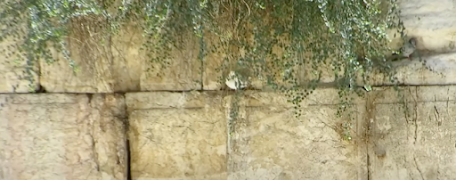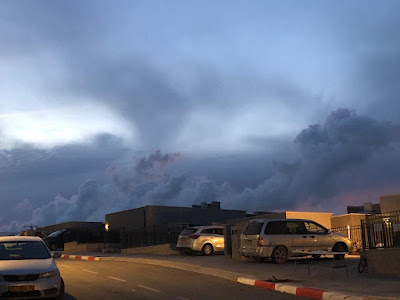This Year, Maybe ...
Walking down the sloping tree lined street, still feeling the depth and passion of the Rabbi's words about Yirmiyahu HaNavi, sadness slowly encircles me. Why so much tragedy, why so much suffering? A gentle breeze comes, scented with blossoms of healing fragrance. The air this evening is intoxicating and consoling.
Could this be the same coolness that accompanied the men of Yehuda as they fought a relentless battle against the multitudinous and fortified Sancheriv's army?
Was this wafting air the same that guided Yehoshua's scouts as they spied out the Land prior to bringing our ancestors across the Yarden? These early pioneers coming to claim their inheritance, the soon to be Shevatim of HaShem's nation on earth.
Is this the moist air that blessed and refreshed the early settlers as they fought the Jordanian army attacking them? Had these same inheritors been reincarnated into the Jews who selflessly cleared the Hula swamps? These European wanders returned to their Yerusha and prepare the future Jewish Homeland for G-d’s children?
In layers of earth beneath this Rehavia street paved in the 1920’s, I envision covering thousands of battles fought for survival. My feet slowly pass over millions of ancient footsteps that went along this same path. The thoughts of our Jewish People and their long shadow of tragedy flows though the evening air. The sensuous aroma contrasts with the images of clashing swords, sand and dust. A capsule of time-travel. As I try to hold onto the images they keep becoming fainter and then fade into the glow of the evening’s moon. The combination of the Rabbi’s vivid details surrounding Yirmiyahu captured my imagination and and set the scene for my short walk through centuries on the way home
Tuesday is a fast day and heralds the apex of the sizzling summer. Hot and humid and heavy with meaning. I don’t welcome the message, but I do feel comfort in the warmth of the sun. Nothing compares to the stimulation of living in Jerusalem, where every stone, tree, and the earth under your feet have a story of its own.
This tzom of the 17th of the month of Tammuz foreshadows the approaching days known as the “Three Weeks,” building in intensity to its culmination on the 9th of the month of Av, called Tisha B’Av. Biblically, the saddest interval of the Jewish calendar. It always weighs heavily on my mind and emotions. A timespan swollen with denial, death, and persecution. One would think that after many years of reliving this, one’s emotions could glide through this sorrow. But no, each year the words of Eicha and its images return, to remind us of the spiritual pain, when our glorious Temple was destroyed. Our devastated and crushed people were dragged into the golus to wander through civilizations that are no more.
Once we have relived our shame, we are soothed by the nehama of Menachem Av and the Haftorahs of consolation. Solace from Neviim that yet again Jews will return to our ancient Land. Children and old people will once again sit in its parks, the Temple will be rebuilt IY"H, and we will be embraced openly by G-d once more for all the world to see.
A recent wildfire in the Jerusalem forest sent billowing smoke into nearby streets and homes. People were evacuated. The acrid smell of the air from the smoke and fire made its way into Rehavia and filled my nostrils with a pungent aroma as if I were once more experiencing that 70 CE catastrophe. An instant of reflective fear, a flash of fright and I became attached to mourning our national calamity.
I have come Home, and now my eyes behold the rebuilding and flourishing of Yerushalayim, the city rising from its ancient ruins, blooming with precious children and vibrant life.
I don’t know why the Israelis I see and meet on the streets of Yerushalayim merit such a revelation. With their very lives they are the fulfillment of the prophecies. With their very lives they are rebuilding. The commentators of the Talmud, Sanhedrin, Prophetic Writings describe the era before Moshiach arrives. And say that this generation will be the reincarnation of those who stood at Mount Sinai. Where there is much holiness there also exists much tumah, says the Torah. Deception is needed to confuse the evil forces so that the holiness can blossom under the nose of the Sitra Achra, so to speak. This is why it says we blow Shofar on Yom Kippur, to confuse the Satan. Therefore, beneath the seeming zenus (immorality) are neshomas waiting for Hashem to call them to teshuva so that the Geula can begin.
So it is during these hot, humid and profound days, a vision of the rebuilt Har HaBayit is granted to some on Shabbos Chazon, this year the 6th Av, Shabbos Devarim. I will await a glimpse of the future Temple and the coming of Moshiach Tzidkeinu.
Could this be the same coolness that accompanied the men of Yehuda as they fought a relentless battle against the multitudinous and fortified Sancheriv's army?
Was this wafting air the same that guided Yehoshua's scouts as they spied out the Land prior to bringing our ancestors across the Yarden? These early pioneers coming to claim their inheritance, the soon to be Shevatim of HaShem's nation on earth.
Is this the moist air that blessed and refreshed the early settlers as they fought the Jordanian army attacking them? Had these same inheritors been reincarnated into the Jews who selflessly cleared the Hula swamps? These European wanders returned to their Yerusha and prepare the future Jewish Homeland for G-d’s children?
In layers of earth beneath this Rehavia street paved in the 1920’s, I envision covering thousands of battles fought for survival. My feet slowly pass over millions of ancient footsteps that went along this same path. The thoughts of our Jewish People and their long shadow of tragedy flows though the evening air. The sensuous aroma contrasts with the images of clashing swords, sand and dust. A capsule of time-travel. As I try to hold onto the images they keep becoming fainter and then fade into the glow of the evening’s moon. The combination of the Rabbi’s vivid details surrounding Yirmiyahu captured my imagination and and set the scene for my short walk through centuries on the way home
Tuesday is a fast day and heralds the apex of the sizzling summer. Hot and humid and heavy with meaning. I don’t welcome the message, but I do feel comfort in the warmth of the sun. Nothing compares to the stimulation of living in Jerusalem, where every stone, tree, and the earth under your feet have a story of its own.
This tzom of the 17th of the month of Tammuz foreshadows the approaching days known as the “Three Weeks,” building in intensity to its culmination on the 9th of the month of Av, called Tisha B’Av. Biblically, the saddest interval of the Jewish calendar. It always weighs heavily on my mind and emotions. A timespan swollen with denial, death, and persecution. One would think that after many years of reliving this, one’s emotions could glide through this sorrow. But no, each year the words of Eicha and its images return, to remind us of the spiritual pain, when our glorious Temple was destroyed. Our devastated and crushed people were dragged into the golus to wander through civilizations that are no more.
Once we have relived our shame, we are soothed by the nehama of Menachem Av and the Haftorahs of consolation. Solace from Neviim that yet again Jews will return to our ancient Land. Children and old people will once again sit in its parks, the Temple will be rebuilt IY"H, and we will be embraced openly by G-d once more for all the world to see.
A recent wildfire in the Jerusalem forest sent billowing smoke into nearby streets and homes. People were evacuated. The acrid smell of the air from the smoke and fire made its way into Rehavia and filled my nostrils with a pungent aroma as if I were once more experiencing that 70 CE catastrophe. An instant of reflective fear, a flash of fright and I became attached to mourning our national calamity.
I have come Home, and now my eyes behold the rebuilding and flourishing of Yerushalayim, the city rising from its ancient ruins, blooming with precious children and vibrant life.
I don’t know why the Israelis I see and meet on the streets of Yerushalayim merit such a revelation. With their very lives they are the fulfillment of the prophecies. With their very lives they are rebuilding. The commentators of the Talmud, Sanhedrin, Prophetic Writings describe the era before Moshiach arrives. And say that this generation will be the reincarnation of those who stood at Mount Sinai. Where there is much holiness there also exists much tumah, says the Torah. Deception is needed to confuse the evil forces so that the holiness can blossom under the nose of the Sitra Achra, so to speak. This is why it says we blow Shofar on Yom Kippur, to confuse the Satan. Therefore, beneath the seeming zenus (immorality) are neshomas waiting for Hashem to call them to teshuva so that the Geula can begin.
So it is during these hot, humid and profound days, a vision of the rebuilt Har HaBayit is granted to some on Shabbos Chazon, this year the 6th Av, Shabbos Devarim. I will await a glimpse of the future Temple and the coming of Moshiach Tzidkeinu.



Comments
Post a Comment